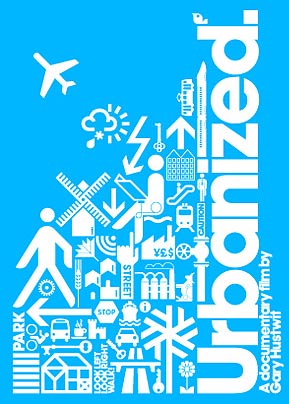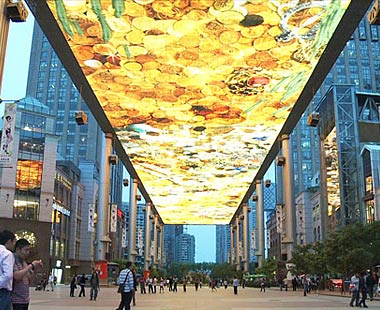 For those who argue that city living represents the Great Green Future, Urbanized, the latest from filmmaker Gary Hustwit (Helvetica, Objectified) is pure eye candy. It’s a sensuous, slant-lit tour of the urban world and all its promise and problems. Workers labor like ants on a Beijing skyscraper. Kids chase kites through a shantytown in Santiago. The camera slides silently along a train line through an eerily vacant downtown Detroit. (For a taste, check out the trailer, below.)
For those who argue that city living represents the Great Green Future, Urbanized, the latest from filmmaker Gary Hustwit (Helvetica, Objectified) is pure eye candy. It’s a sensuous, slant-lit tour of the urban world and all its promise and problems. Workers labor like ants on a Beijing skyscraper. Kids chase kites through a shantytown in Santiago. The camera slides silently along a train line through an eerily vacant downtown Detroit. (For a taste, check out the trailer, below.)
The clips of cyclists in Copenhagen alone make the film worth watching. Copenhagen is a city of 1.2 million people where 37 percent of commuters commute to work by bike. (One student told Reuters, “Only when there’s half a meter of snow outside would I consider using the underground.” Talk about Viking heritage — that shit’s just burly.) And a bike ride around Bogotá with former Mayor Enrique Peñalosa will get even recreational cyclists all giddy with possibility.
Urbanized is also a testament to the power of people and communities to shape the urban landscape (stroll on the High Line, anyone?), and the importance of including residents in planning efforts (yes, it’s another paean to the late people’s champion Jane Jacobs).
But as with many of the recent contributions to the urbanist canon, Urbanized has a huge blind spot. Lost in all the excitement over the “urban renaissance” is the fact that Americans, at least, haven’t yet bought into it.
The film starts with the numbers that you’ve no doubt heard by now: More than half of the world’s population lives in urban areas. By mid-century, these areas could house 75 percent of humanity — a huge number of them in slums.
It’s strong backing for one of the film’s central messages: We need to figure out how to make cities work, lest we end up with a planet of slums and inhumane, automobile-centered megalopolises. But what the film doesn’t mention is that, in much of this accounting, “urban” or “metropolitan” areas include suburbs, and, at least in the U.S., suburbs continue to cast a long shadow over cities.
Between-year Census numbers stoked much excitement last year (from this corner, among many others) when they suggested that, for the first time in a generation in many metropolitan areas, white people were shunning the suburbs in favor of city living. “A new image of urban America is in the making,” William Frey, a demographer with the Brookings Institution, told the Associated Press. “What used to be white flight to the suburbs is turning into ‘bright flight’ to cities that have become magnets for aspiring young adults who see access to knowledge-based jobs, public transportation, and a new city ambiance as an attraction.”
Richard Florida, king of the “Creative Class,” was probably doing parkour he was so happy.
But oops: We spoke too soon.
When the final 2010 Census came in, it made clear that we’re not walking away from our lawn tractors and two-car garages anytime soon. An analysis of eight metro areas, including Chicago, Washington, D.C., and Austin revealed that in the past decade, 96 percent of the population growth occurred in the suburbs. Some took great exception to this analysis, but Brookings’ Frey later confided, “The sad truth of the matter is that there’s really very little information on this back-to-the-city thing, at least from a demographic standpoint.”
That’s not to say that we’re not on the verge of something here. A huge majority of Millennials — and a goodly number of their Boomer parents — say they want to live in cities. It just appears that, by and large, it’s an aspirational notion. Life’s not so bad out on the fringe: The schools are good, crime is infrequent, there’s room in the driveway for the Jetski and the quads …
But in true urbanist form, Urbanized strays into the suburbs only long enough to ridicule them. Phoenix lawyer/developer Grady Gammage Jr. makes a pitch for his big lawn and the “automobile-driven post-war urban fabric” and comes off as a total goober. The obvious message: The ‘burbs are for losers. (If so, an awful lot of Americans are losers. Looking at the numbers above, urbanists would lose that fight, so let’s not go there.)
I don’t mean to pick on Hustwit here. The film is glorious. We can all take comfort in the anecdotes that it brings to light — a community garden takes root in Detroit, a new network of walkways springs up in a South African township, a street art project helps residents of Tidy Street in Brighton, England, reduce their energy use. And Hustwit is not the only one who has failed to notice this particular elephant in the corner.
After the film, Hustwit was quick to say that he’s not out to bash the ‘burbs. “I grew up in the suburbs,” he said. “I’m not making a message film. This is just an exploration of cities around the world, and people trying to do interesting things.”
And fair enough — anybody ever seen a film about the suburbs that left them feeling upbeat about where the world is headed? (No really, anyone?)
Well, note to filmmakers: We could use a few of those. There’s plenty of interesting work being done to “green” the urban fringe. Ellen Dunham Jones, an architecture and urban design prof at Georgia Tech who makes numerous appearances in the film, could have shed some light on that. She wrote a book about it called Retrofitting Suburbia.
In the meantime, perhaps Urbanized will at least convince a few thick-skinned suburbanites that a new ultra-modern couch set does not an urban lifestyle make. To get that, you’ll need to ditch the lawn tractor and move to town.



